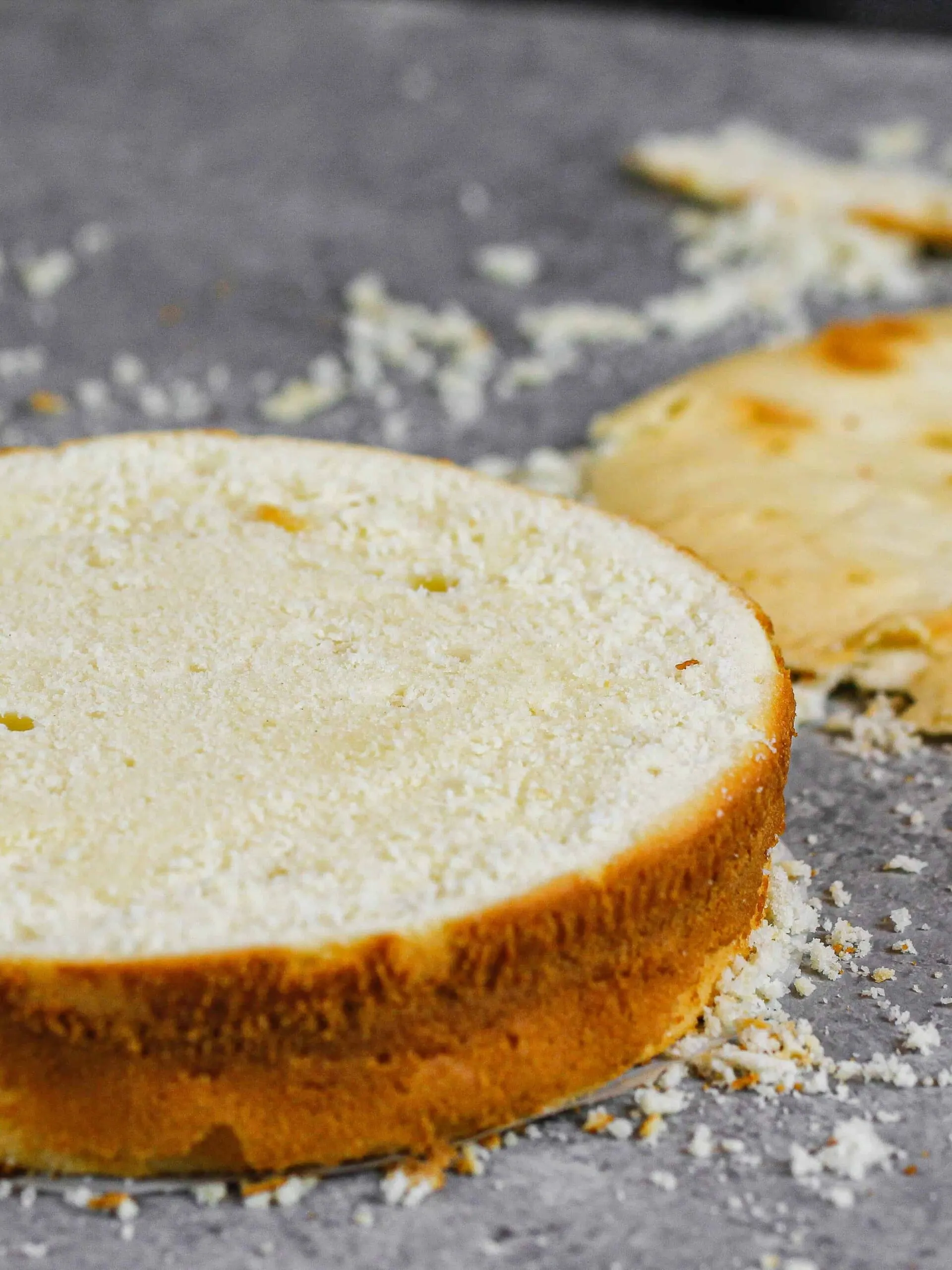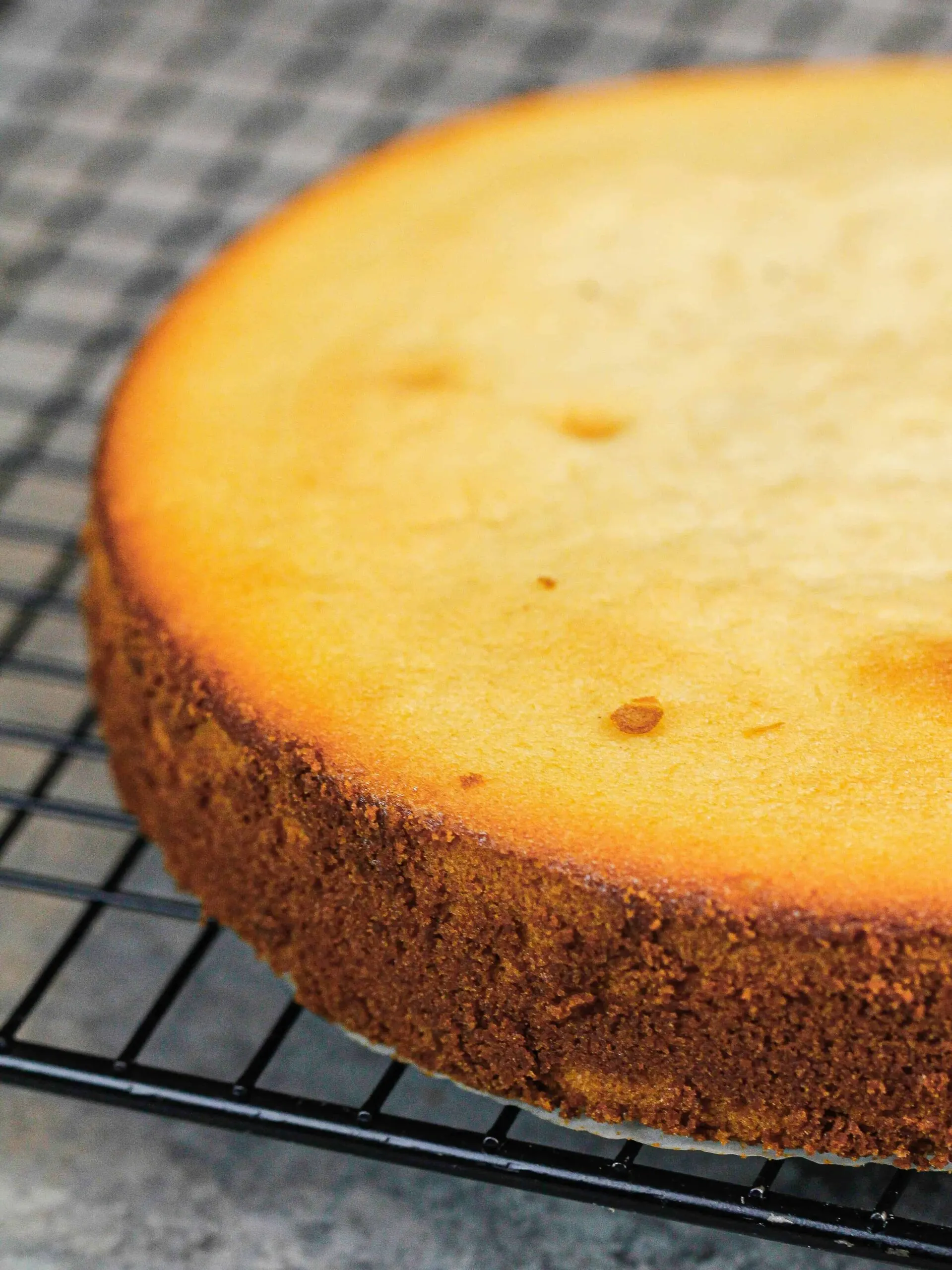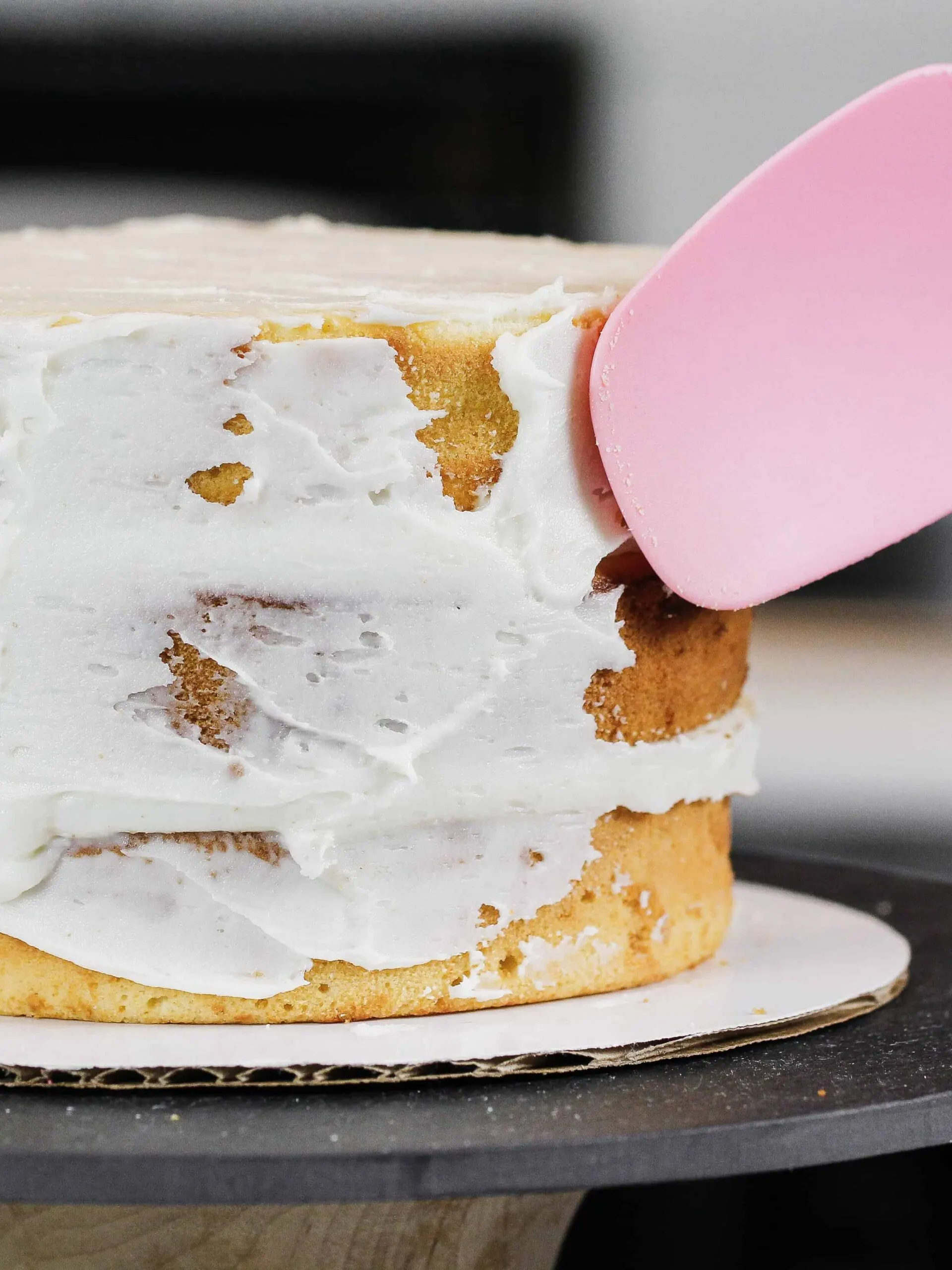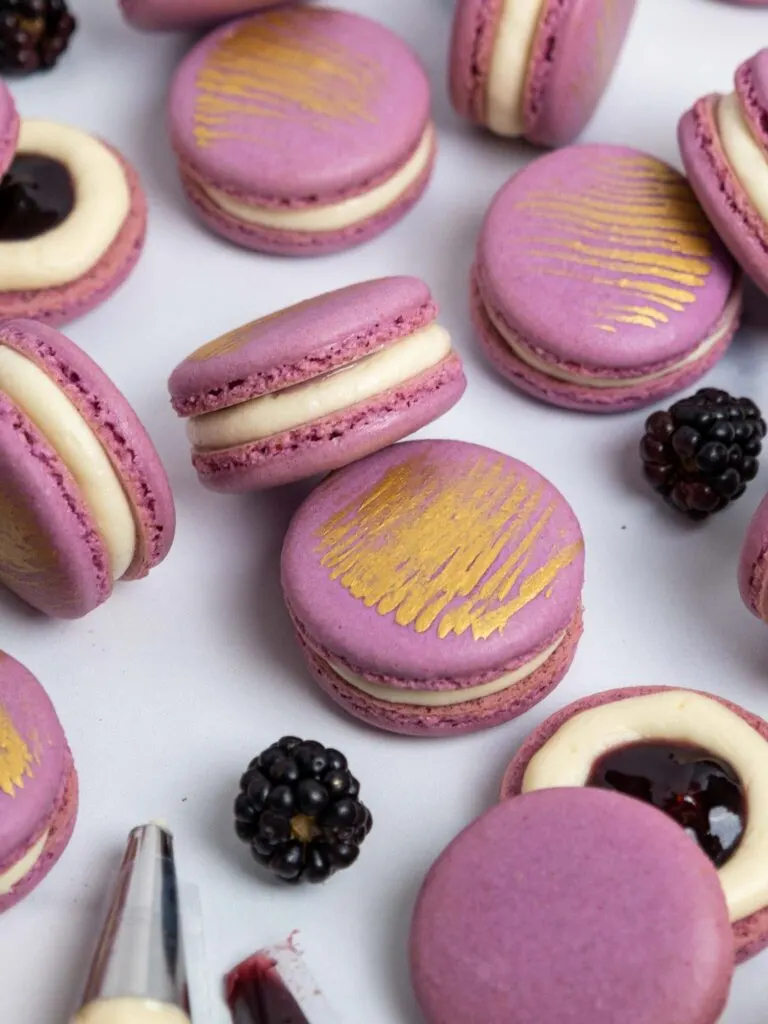Baking really is a science. There are a lot of things that go awry when making a cake. I’ve lost count of the number of frantic emails and messages I’ve received about cake mishaps over the years. To make life easier for all of us, I’ve created this cake troubleshooting guide.
While I always do my best to answer your questions, I figured I’d streamline the process by sharing troubleshooting tips on the most common issues people run into with cakes.
It’s also easier to have pictures of common problems, to help you identify what might have happened if your cake turns out less than perfect.

The Most Common Cake-Related Problems
This post mainly covers problems related to how a cake batter is made and how cake layers are baked.
It does not cover ingredient substitutions, which can also have a huge impact on the way a recipe turns out.
That’s a whole different topic, which I’ve covered in a separate ingredient substitutions post!
The questions I’ll be covering in this cake troubleshooting guide include:
- Why is my cake dense or gummy?
- What caused my cake layers to be dry?
- Why did my cake layers sink in the middle?
- How can I get my cake out of my pan without breaking it?
- How can I prevent my cake edges from burning or caramelizing so much?
- Why do my cake layers have big holes in them?
- Why is my cake falling apart and crumbling when I try to frost it?
- How do I know if my cake layers are done baking?
- Why didn’t my cake layers rise more?
- What causes my frosting to bulge out between the cake layers?
- Why is my frosting cracking on my cake?
My hope is that this cake troubleshooting guide will help you understand what caused your problem and empower you to bake amazing cakes in the future. So, without further ado, let’s dive in!
Why is my cake dense or gummy?
What might have happened:
- Too much flour was added to the batter.
- The cake batter was over-mixed.
- The ingredients weren’t at room temperature.

How to prevent this in the future:
- Be sure to properly measure your flour by fluffing it, then spooning and leveling each cup, or use a digital kitchen scale.
- Mix your batter just until the ingredients are incorporated once you’ve added in your flour. Over-mixing the batter causes strong gluten strands to form, which give your cake that dense texture.
- If some of your ingredients are cold, they make it more difficult to mix together your batter and can impact the rise of your cake. Be sure to set out cold ingredients ahead of time, so that all your ingredients are at room temperature when it’s time to make your cake.

Why is my cake dry?
What might have happened:
- The cake layers were baked too long.
- The recipe doesn’t have enough moisture or needs simple syrup.

How to prevent this in the future:
- Try to take your cake layers out a few minutes earlier, or as soon as a toothpick comes out with a few moist crumbs. If the toothpick comes out totally clean, your cake might already be over-baked. Remember that your cake layers will continue to bake for a few minutes once they’re out of the oven as they cool in the pans. I always try to err slightly on the side of underbaking for this reason.
- Different recipes make different types of cake. For instance, my vanilla cake recipe is a butter cake recipe that’s quite moist and doesn’t need simple syrup. But sponge cake recipes bake up quite a bit fluffier and drier because they use a lot of eggs. These cake recipes are designed to bake that way and are then supposed to be doused in simple syrup to add moisture after they’re baked.
Why did my cake layers sink in the middle?
What might have happened:
- The cake layers are underbaked.
- The oven door was opened and slammed while the layers baked.
- There’s too much leavening agent in the batter (baking powder / baking soda).
- Your oven temperature is off.

How to prevent this in the future:
- Bake your cake layers a couple minutes longer, or until a toothpick comes out with a few moist crumbs.
- While it’s common practice to rotate cake pans part way through baking, if the oven door is slammed this can cause partially baked cake layers to sink in the middle. If you need to rotate your pans, be sure to carefully close your oven door after doing so.
- Be sure to carefully read how much and what type of leavening agents a recipe calls for, and measure them precisely. The recipe might also be bad! If you try making it a few times and this still is happening, you may want to try a new recipe.
- Test your oven temperature with an oven thermometer. If yours runs cold, adjust the temperature of your oven to ensure it bakes the cake layers at the actual temperature the recipe calls for.
My cake layers are stuck in my pans! How do I get them out?
What might have happened:
- The cake pans weren’t properly greased.
- Your cake pans weren’t lined with parchment paper.
- The cake layers fully cooled in the pan.

How to prevent this in the future:
- Generously grease your cake pans with non-stick spray or a layer of butter and flour
- When a recipe asks you to line your pan with parchment paper, be sure to do so! I love to use pre-cut parchment rounds to simplify the process, but you can also cut out your own parchment rounds.
- If your cake layers cool fully in the pan they can get stuck as the cake firms up. Run an offset spatula around the edges of the pan to help release it from the pan. Then dip the bottom of the pan in hot water. This should help it pop out without breaking the cake layer.
Why are my cake edges so dark and caramelized?
What might have happened:
- The pans used to bake the layers aren’t the right material.
- Your oven runs hot.
- The pans are overcrowded in the oven.

How to prevent this in the future:
- The material of you cake pans has a big impact on how your cake layers bake. Dark metals absorb and spread heat more efficiently than lighter-colored pans which causes cakes to over brown on the sides. Glass pans also become very hot once heated and can cause cake layers to over-brown or caramelize too. Use a light-colored metal pan, like these cake pans which do a better job of evenly distributing heat.
- Test your oven with an oven thermometer. If yours runs hot, turn the temperature of your oven down to ensure it bakes the cake layers at the actual temperature the recipe calls for.
- Make sure your pans are spread out in your oven, and not placed too close to the walls of your oven to help them bake evenly. You can also use cake strips to prevent browning. I don’t enjoy using them, but some people swear by them!
Why do my cake layers have big holes / tunnels in them?
What might have happened:
- The batter was over-mixed.
- The batter was mixed at too high of a speed.
- The ingredients weren’t properly mixed or weren’t at room temperature.

How to prevent this in the future:
- Tunneling can happen in your cake layers when the gluten strands are too strong, which traps air bubbles inside the cake. Mix your cake batter on a low speed just until the ingredients are combined to avoid this.
- Unless a recipe specifically calls for mixing batter at a high speed (like a sponge cake, or when creaming together butter and sugar), you shouldn’t be mixing your batter that fast. Follow the recipe instructions closely and mix the batter at the speed the recipe calls for.
- Concentrated areas of baking powder or baking soda in your batter can create big holes in your cake layers. Be sure your ingredients are at room temperature to help the batter mix together better and sift your dry ingredients if a recipe calls for it.
Why is my cake falling and crumbling apart when I try to frost it?
What might have happened:
- The cake layers weren’t fully cooled.
- You’re not using the right tools.
- The frosting you’re using is too stiff.

How to prevent this in the future:
- Cool the cake layers fully before you frost them. Otherwise, you’ll end up with a real mess on your hands! Give them a couple hours to cool at room temperature on a wire rack or pop them into the freezer to accelerate the process. I like to chill my cake layers in the freezer for about 20 minutes before decorating a cake, so that they’re cold to the touch. This reduces crumbing and makes them so much easier to stack and frost.
- An offset spatula makes a world of a difference when decorating a cake. On the other hand, trying to spread frosting onto cake layers with a rubber spatula isn’t a good idea. The lack of control and precision make it a lot harder to properly spread the frosting and can definitely increase the risk of tearing cake layers.
- If your frosting consistency is too thick, this can also make it challenging to spread. The resistance from the thickness of the frosting can cause cake layers to tear. If the frosting seems difficult or too thick to work with, add in additional heavy cream or milk 1 tablespoon at a time until the consistency is more spreadable.
Why are my cake layers overcooked or under-baked?
What might have happened:
- Your oven temperature is off.
- The pans are overcrowded in the oven.
- You baked different sized cake layers than a recipe called for.

How to prevent this in the future:
- Test your oven temperature with an oven thermometer. If yours runs hot or cold, adjust the temperature of your oven to ensure it bakes the cake layers at the actual temperature the recipe calls for.
- Make sure your pans are spread out in your oven and not placed too close to the walls of the oven to help them bake evenly.
- If you make different sized cake layers than a recipe calls for, it can change the bake time. Be sure to keep an eye on your cake layers and test them with a toothpick. Remove them from the oven when a toothpick comes out with a few moist crumbs.
Why didn’t my cake layers rise more?
What might have happened:
- Your leavening agents are old.
- The recipe isn’t meant to rise much.
- The batter was over-mixed.
- You used baking powder instead of baking soda on accident.

How to prevent this in the future:
- Baking powder and baking soda have a long shelf life, but they don’t stay good forever. If you’re worried about yours, you can test baking powder by adding a little bit into a small bowl of hot water (or vinegar if testing baking soda). They should react and start to fizzle right away. If they don’t, they’re no longer good.
- Some recipes are formulated to rise a lot, others are not. My chocolate layer cake recipe and vanilla cake recipe are designed to bake flat without a big dome. As long as the texture and taste are good, it’s ok if your cake layers don’t rise up a ton. Sometimes that’s how they’re supposed to be!
- Over-mixing your batter prevents the leavening agent from rising up like normal and traps it inside the batter where it creates tunnels and big holes. Mix just until the ingredients are combined to create light and fluffy cake layers.
- Be sure you’re using the right leavening agent. Baking soda is about 3x more potent than baking powder, and they are not interchangeable.
Why is my frosting bubbling or bulging out between the cake layers?
What might have happened:
- The cake layers weren’t leveled.
- The frosting you’re using is too thin.
- The cake hadn’t settled before adding the final layer of frosting.

How to prevent this in the future:
- Level the cake layers with a serrated knife. It makes it way easier to assemble a layer cake and help prevent air from getting trapped between the cake layers and escaping through the frosting later.
- Make sure your frosting is the right consistency. It can get pushed out between the cake layers as they settle if it’s too thin. Next time you make frosting either add more powdered sugar or use less milk/heavy cream. If you’re not sure what consistency you’re looking for, you can check out this detailed post on frosting consistency.
- After leveling and filling your cake, let it settle for a couple hours or preferably overnight before adding your second layer of frosting.
Why is my frosting cracking on my cake?
What might have happened:
- Air was trapped between your cake layers.
- The cake layers weren’t leveled.
- Your cake wasn’t settled before adding the final layer of frosting.
- Your cake is made with a filling that’s too soft.

How to prevent this in the future:
- Press down on the top layer with your hands to push out any air that might be trapped in the frosting between your cake layers. Then crumb coat your cake and carry on as usual!
- Leveling your cake layers with a serrated knife makes it much easier to assemble a layer cake, and helps the cake settle easily and without any big shifts that can crack your frosting.
- Let the cake settle for a couple hours or preferably overnight before adding your second layer of frosting.
- If your cake has a soft filling, it can seep out as your cake settles. Pipe a frosting dam around the edge of each cake layer if you plan to use a softer filling in your cake.

Any Questions I Missed in this Cake Troubleshooting Guide?
If you found this cake troubleshooting guide helpful, please let me know in the comments section below!
If you have a cake issue that I didn’t cover, please share it so we can figure it out together 🙂
Other Posts You Might Like





How To Make Pound Cakes Lighter And Smoother? - Lulu Recipes
Sunday 20th of October 2024
[…] can read this cake troubleshooting guide for further tips for your […]
David
Sunday 13th of October 2024
My lemon cake batter doesn't come out yellow after baking, it comes out a tan color. The flavor is excellent, I'm just not happy with the color.
Chelsweets
Sunday 20th of October 2024
Hi David,
It can vary depending on the cake recipe you're using! Lemon itself doesn't really create a yellow color, some people either use extra egg yolks to make it more yellow or some use food coloring. Are the pictures of the recipe you're making really yellow?
cyrus davis
Wednesday 17th of July 2024
Very well done. The pictures were very helpful. Kudos!
Sue
Monday 15th of July 2024
Hi my carrot cake recipe has turned out with light marbling not sure why?
Jody Gibson
Monday 8th of July 2024
Hi Chelsey, I think one thing I struggle with is that I have a 27" oven and pan overcrowding is an issue. I just made your Oreo cake and baked all three 8x2 Fat Daddies pans at once for 32 minutes, but they were pulled away from the edges and had shrunk a bit.
What I would love to do is to use 8x4 pans and torte the cakes so I only have two pans in the oven and they have plenty of room, but I have no idea how to convert recipes for this situation. I think you have a 27" oven as well (or did) so I thought I'd ask for your thoughts.
Thanks!
Chelsweets
Sunday 14th of July 2024
Hi Jody,
I can totally relate! Is your oven gas or electric? My tiny original oven was gas and even though the layers were def crowded, it actually baked pretty evenly/well! But I did have to rotate the laters between the racks to get them to bake evenly. A little bit of shrinkage is ok/normal once the layers have baked and cooled, but it sounds like you're dealing with a lot of shrinkage!
A lot of my recipes use the reverse crumbing method, and those types of recipes don't do great baking in an 8x4-inch pan. They'd just take a long to bake through, and you'd get a ton of caramelization in the process. But you can give it a try and see if it turns out better in your oven! If you try it, please let me know how it turns out!